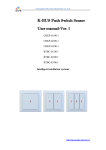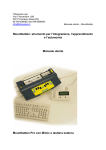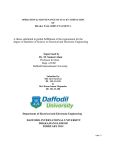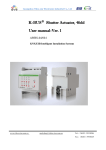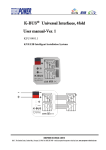Download K-BUS R 6 Buttons Touch panel User manual
Transcript
Guangzhou Video-star Electronics Industrial Co., Ltd R K-BUS○ 6 Buttons Touch panel User manual-Ver. 2 CHTB-06/01.1.10 KNX/EIB Intelligent Installation Systems www.video-star.com.cn [email protected] Tel.: (8620)39338986 Fax: (8620)39338465 R GVS K-BUS○ KNX/EIB 6 Buttons Touch panel Contents 1. Summary ----------------------------------------------------------------------------------------------------------------------------------------- 3 2. Technical data ---------------------------------------------------------------------------------------------------------------------------------- 4 3. Structure and dimension diagram------------------------------------------------------------------------------------------------------- 5 3.1 Dimension diagram --------------------------------------------------------------------------------------------------------------------------- 5 3.2 Structure ----------------------------------------------------------------------------------------------------------------------------------------- 6 4. Project design and programming -------------------------------------------------------------------------------------------------------- 7 4.1 Overview of the functions ------------------------------------------------------------------------------------------------------------------ 7 5. Parameter setting description in the ETS -------------------------------------------------------------------------------------------- 7 5.1 Parameter window ―General‖ -------------------------------------------------------------------------------------------------------------- 7 5.2 Independent working mode ----------------------------------------------------------------------------------------------------------- 9 5.2.1 ―Switching‖ function ------------------------------------------------------------------------------------------------------------------- 9 5.2.2 ―Dimming‖ function ------------------------------------------------------------------------------------------------------------------10 5.2.3 ―Blind‖ function ------------------------------------------------------------------------------------------------------------------------12 5.2.4 ―Value sender‖ function --------------------------------------------------------------------------------------------------------------15 5.2.5 ―Scene‖ function -----------------------------------------------------------------------------------------------------------------------16 5.3 Linked working mode -----------------------------------------------------------------------------------------------------------------17 5.3.1 ―Switching‖ function ------------------------------------------------------------------------------------------------------------------17 5.3.2 ―Dimming‖ function ------------------------------------------------------------------------------------------------------------------18 5.3.3 ―Blind‖ function ------------------------------------------------------------------------------------------------------------------------21 5.3.4 ―Value sender‖ function --------------------------------------------------------------------------------------------------------------23 5.3.5 ―Scene‖ function -----------------------------------------------------------------------------------------------------------------------25 5.4 Parameter window ―LED function‖ -----------------------------------------------------------------------------------------------27 2 www.video-star.com.cn [email protected] Tel.: (8620)39338986 Fax: (8620)39338465 R GVS K-BUS○ KNX/EIB 6 Buttons Touch panel 1. Summary The Touch panel is used in building control systems, which can be mounted on a flush-mounted bus coupler. At the same time, the application module can be also connected with other devices for a system on the bus, and the functions are both simple to operation and intuitive. Users can program it according to the requirement to implement the function systematically. This manual provides detailed technical information about the switch sensor for users as well as assembly and programming details, and explains how to use the Touch panel by the application examples. The Touch panel can be used to control the switch, dimming, blinds, and scene, etc. Each button of the Touch panel correspond one LED with two colors indication. The device can be installed in a conventional 86 mm wiring box. The bus coupler that connected the Touch panel connects to the bus though the EIB connection terminals and has no use for additional supply voltage. It is available to assign the physical address and set the parameters by Engineering design tools ETS with VD3/VD4 (higher than edition ETS3). The Touch panel can be used in a wide variety of application areas. The following list provides an overview: switching and dimming control of blinds and shutters Sending of values, e.g. water line、brightness. recall and storage scene LED indication Each button of a device can adopt any of the functions described above, and is independent of each other. In addition, left button of touch panel can also be used in association with right button, depend on parameter settings. 3 www.video-star.com.cn [email protected] Tel.: (8620)39338986 Fax: (8620)39338465 R GVS K-BUS○ KNX/EIB 6 Buttons Touch panel 2. Technical data Power supply Bus voltage 21-30V DC,via the EIB bus Current consumption, bus <12mA Power consumption, bus <360mW Operating and Corresponding 1 LED indication for The LEDs have two colors display each button Programming LED and button For assignment of the physical address connections EIB/KNX Via bus connection terminal Temperature rang Operation – 5 °C ... 45 °C Storage – 25 °C ... 55 °C Transport – 25 °C ... 70 °C Design Embedded installation of equipment Dimensions 86×86×32mm (application module) 50.7×45.46×23.1mm (coupler) Installation in a conventional 86 mm wiring box Weight 0.15KG Housing/color Plastic + glass housing, white 4 www.video-star.com.cn [email protected] Tel.: (8620)39338986 Fax: (8620)39338465 R GVS K-BUS○ KNX/EIB 6 Buttons Touch panel 3. Structure and dimension diagram 3.1 Dimension diagram CHTB-06/01.1.10 5 www.video-star.com.cn [email protected] Tel.: (8620)39338986 Fax: (8620)39338465 R GVS K-BUS○ KNX/EIB 6 Buttons Touch panel BTBC-01/00.1 3.2 Structure 1. 2. 3. 4. Application module 10-pin plug, to connect application module and the coupler Bus coupler EIB bus connect terminal 6 www.video-star.com.cn [email protected] Tel.: (8620)39338986 Fax: (8620)39338465 R GVS K-BUS○ KNX/EIB 6 Buttons Touch panel 4. Project design and programming 4.1 Overview of the functions Max. number of Max. number of Max. number of communication objects group addresses associations 24 50 50 Application program 6 Button Touch pannel The following applications can be set separately for each button of the touch panel: Switch The application can be used for switching the lighting, such as relay, dimmer, etc. Switch / Dimming The application can be used for switching/dimming the lighting and is distinguished between long and short operation. The manner of dimming can be selected between start-stop dimming and step-wise dimming. Blind and Shutter The application can make the Shutter or Roller blind movement or lamella adjustment, and there is distinguish between long and short operation, a short operation will execute movement and a long operation will execute adjustment/stop. Value sender The application can be used for sending the different values or data types. Light scene control with storage function With the application, a short operation will recall a scene and a long operation will storage the current scene. LED function LED can be used for status display or the function display. The LED can light up in two colors. 5. Parameter setting description in the ETS 5.1 Parameter window “General” Parameter window ―General‖ can be shown in fig. 5.1. There used to set the working mode for each button, 7 www.video-star.com.cn [email protected] Tel.: (8620)39338986 Fax: (8620)39338465 R GVS K-BUS○ KNX/EIB 6 Buttons Touch panel the left and right buttons are used in association or independently. Fig.5.1 Parameter window ―General‖ Parameter “Button 1-2/3-4 use” This parameter is used to set the working mode for each button. Options: 2 independent push buttons Linked push button If selecting ―2 independent push buttons‖, the left and right buttons of the panel are used independently. If selecting ―linked push button‖, the left and right buttons of the panel are used in association. The following sections details parameters and communication objects of each application in the two working modes, using one push button or left/right buttons as an example. Parameter “Debounce time” It can set the vibration time to prevent unwanted multiple operation by bouncing of contacts in vibration time, which means the effective time of the contact operation. Options: 10ms/…/150ms 8 www.video-star.com.cn [email protected] Tel.: (8620)39338986 Fax: (8620)39338465 R GVS K-BUS○ KNX/EIB 6 Buttons Touch panel 5.2 Independent working mode In each case, the applications make a separate set of parameters and communication objects available for the left and right buttons. 5.2.1 “Switching” function Parameter window ―Switching‖ can be shown in fig. 5.2. With the application, a switching telegram is sent out for an operation or upon release of the button. Fig.5.2 Parameter window ―Switching‖ Parameter “Reaction on rising edge”/“Reaction on falling edge” Via the parameters you can set which 1-bit value is sent out for every operation on rising edge and falling edge. This can be an ON telegram, an OFF telegram or a toggle telegram. Alternatively, no telegram can be sent out for an operation using the ―No reaction‖ setting. Options: No reaction On Off Alternating on/off ―Alternating on/off‖ means that switching is always between ON and OFF. For example, if an ON telegram was last sent out, then a renewed operation of the button will trigger an OFF telegram. When the button is 9 www.video-star.com.cn [email protected] Tel.: (8620)39338986 Fax: (8620)39338465 R GVS K-BUS○ KNX/EIB 6 Buttons Touch panel operated again, an ON telegram is sent out, etc. The button thus always remembers the last state and then switches over to the other value. Communication object “switching”, 1bit According to the parameter setting, the object is used to send out an ON telegram or an OFF telegram, or a toggle telegram via rising edge or falling edge of the button. 5.2.2 “Dimming” function Parameter window ―Dimming‖ can be shown in fig. 5.3. With the application, a push button has two communication objects for switching and for dimming. A distinction is made between short operation and long operation. A short operation will execute switching; a long operation will execute dimming. A ―switching‖ switching telegram is sent out on the 1-bit communication object. A ―relative dimming‖ dimming telegram is sent out on the 4-bit communication object. Fig.5.3 Parameter window ―Dimming‖ Parameter “duration of long operation=entry×0.1s”(3…30) The parameter is used to define the time which a long operation is recognized. Options: 3~30 Parameter “working mode of the push button for switching” This parameter is used to determine whether a short operation sends out an ON or an OFF telegram via a 1-bit communication object. Alternatively, for the selection ―alternating on/off‖, you can switch between switching on and switching off for every short operation, i.e. after a switch-on telegram has been sent out (or 10 www.video-star.com.cn [email protected] Tel.: (8620)39338986 Fax: (8620)39338465 R GVS K-BUS○ KNX/EIB 6 Buttons Touch panel received), a switch-off telegram will be sent out for a renewed operation. After it is operated again, a switching-on telegram is sent out. Options: Deactivated Off On Alternating on/off Parameter “working mode of the push button for dimming” This parameter is used to determine whether a long operation sends out a dim brighter or a dim darker telegram via a 4-bit communication object. Alternatively, for the selection ―alternating brighter/darker‖, you can switch between dimming up and dimming darker for every long operation, i.e. after a dim brighter telegram has been sent out, a dim darker telegram will be sent out for a renewed operation. After it is operated again, a dim brighter telegram is sent out. Options: Darker Bright Alternating brighter/ darker Parameter “step size for dimming” The parameter is used to specify by how much brighter or darker dimming should occur. The sent out value always relates to the current brightness value. For example, a dimming actuator is currently dimmed to a brightness value of 70%. By operation of the button, a dimming command ―dim by 25% (1/4) brighter‖ is sent out. The dimming actuator will adjust its brightness value to 95% immediately after receiving the dimming command. Options: 1/1 ,1/2,1/4, …,1/32,1/64 Parameter “dimming stop telegram” The parameter is used to determine whether the release of the button will trigger the ―dimming stop‖ command or not. Options: Dimming stop is send Dimming stop is not send With the ―dimming stop is send‖ option, when the button is released, the telegram with the ―dimming stop‖ information is sent out on the 4-bit communication object ―relative dimming‖. Parameter “cyclical sending of dimming telegrams” The parameter is used to determine the telegram with the ―brighter‖ or ―darker‖ information whether is sent out cyclically by a durative long operation. Options: Deactivated Activated 11 www.video-star.com.cn [email protected] Tel.: (8620)39338986 Fax: (8620)39338465 R GVS K-BUS○ KNX/EIB 6 Buttons Touch panel With the ―deactivated‖ option, when triggered a durative long operation, only one telegram with the ―brighter‖ or ―darker‖ information is sent out on the 4-bit communication object ―relative dimming‖. With the ―activated‖ option, when triggered a durative long operation, the telegram with the ―brighter‖ or ―darker‖ information is sent out cyclically on the 4-bit communication object ―relative dimming‖. Parameter “Duration of the telegram repetitions=entry×0.1 s(3…30)” The parameter is only visible if the ―cyclical sending of dimming telegrams‖ parameter is set to ―activated‖. It is used to set the interval time between two telegrams that are sent cyclically, options: 3~30 Communication object “switching”, 1bit According to the parameter setting, the object is used to send out an ON telegram or an OFF telegram, or a toggle telegram via a short operation of the button. Communication object “relative dimming”, 4bit According to the parameter setting, the object is used to send out a dim brighter or a dim darker telegram via a long operation of the button. When the button is released, it is possible that a dim stop telegram is sent out via the object. 5.2.3 “Blind” function Parameter window ―blind‖ can be shown in fig. 5.4. With the application, a push button has two functions to be realized: shutter and roller blind. In the case of shutter, an operation of the button sends out a blind movement command or a slats adjustment command. A short operation always triggers a travel command and a long operation always triggers a slats adjustment command. You can specify whether the shutter control occurs via two 1-bit or two 1-byte communication objects ―travel‖ and ―adjust‖. If the communication object ―adjust‖ is selected to 1-bit, the slats adjustment command can be sent out cyclically. In the case of roller blind, a short operation triggers a travel command and a long operation trigger a stop command, the blind control occurs via two 1-bit communication objects ―travel‖ and ―stop‖. 12 www.video-star.com.cn [email protected] Tel.: (8620)39338986 Fax: (8620)39338465 R GVS K-BUS○ KNX/EIB 6 Buttons Touch panel Fig.5.4 Parameter window ―Blind‖ Parameter “duration of long operation=entry×0.1s (3…30)” The parameter is used to define the time which a long operation is recognized. Options: 3~30 Parameter “cycle time of the telegram repetition= entry×0.1s (3…30)” The parameter is only visible if the ―object type‖ parameter is set to ―1 bit‖. It is used to set the interval time between two telegrams that are sent cyclically for a durative long operation, options: 3~30 Parameter “object type” This parameter is only visible if the ―function switchover blinds/roller shutter‖ parameter is set to ―shutter‖. It is used to define the type of the communication objects ―travel‖ and ―adjust‖. Options: 1bit 1byte Parameter “Function switchover roller blind/ shutter” The parameter is used to determine whether a roller blind or shutter is to be driven by an operation. With the ―roller blind‖ setting, the value for the slats adjustment does not apply. Options: Shutter Roller blind Parameter “value for position down (%)”/“value for position up (%)” This parameter can only be set if ―1 byte‖ has been set as object type, which can be used to set the position (percent values) that a connected blind shall be lowered or raised to. Options: 0~100, the value 0% means travel up completely, the value 100% means travel down completely. 13 www.video-star.com.cn [email protected] Tel.: (8620)39338986 Fax: (8620)39338465 R GVS K-BUS○ KNX/EIB 6 Buttons Touch panel Parameter “value for stats position down (%)”/“value for stats position up (%)” This parameter can only be set if ―1 byte‖ has been set as object type, which can be used to set the position (percent values) that a connected blind slat shall be opened or closed to. Options: 0~100, the value 0% means slat opened completely, the value 100% means closed completely. Communication object “travel”,1bit (shutter) This object is visible if the parameter ―object type‖ is set to ―1bit‖, it is used to send out a shutter movement command (UP or DOWN) on the bus via a short operation of the button. Telegram value ―0‖ UP ―1‖ DOWN Communication object “adjust”,1bit (shutter) This object is visible if the parameter ―object type‖ is set to ―1bit‖, it is used to send out a lamella adjustment command (UP or DOWN) on the bus via a long operation of the button. Telegram value ―0‖ lamella UP ―1‖ lamella DOWN Communication object “travel”,1byte (shutter) This object is visible if the parameter ―object type‖ is set to ―1byte‖, it is used to send out a shutter movement command (UP or DOWN, percent values) on the bus via a short operation of the button. Telegram 0~100, 0 travel up completely 100 travel down completely. Communication object “adjust”,1byte (shutter) This object is visible if the parameter ―object type‖ is set to ―1byte‖, it is used to send out a slats adjustment command (UP or DOWN, percent values) on the bus via a long operation of the button. Telegram 0~100, 0 stat opened completely 100 stat closed completely. Communication object “travel”,1bit (roller blind) This object is visible if the parameter ―function switchover roller blind/shutter‖ is set to ―roller blind‖, it is used to send out a roller blind movement command (UP or DOWN) on the bus via a short operation of the button. Telegram value ―0‖ UP ―1‖ DOWN Communication object “stop”,1bit(roller blind) This object is visible if the parameter ―function switchover roller blind/shutter‖ is set to ―roller blind‖, which is used to send out a roller blind stop telegram on the bus via a long operation of the button. Telegram value ―0‖ or ―1‖ stop 14 www.video-star.com.cn [email protected] Tel.: (8620)39338986 Fax: (8620)39338465 R GVS K-BUS○ KNX/EIB 6 Buttons Touch panel 5.2.4 “Value sender” function Parameter window ―value sender‖ can be shown in fig. 5.5. With the application, two telegrams with the predefined values from two different communication objects can be sent out on rising edge or falling edge of the button. Fig.5.5 Parameter window ―value sender‖ Parameter “object type for rising edge”/“object type for falling edge” The parameters are used to define the data types that are sent when the button is actuated on rising edge and falling edge. The data types specified the bit size of the communication objects and the value range. Options: No reaction 1 bit value [0…1] 2 bit value [0…3] 4 bit value [0…15] 1 byte value [-128...127] 1 byte value [0…255] 2 byte value [-32768...32767] 2 byte value [0...65535] 2 byte value [Float] 3 byte value [time of day] 4 Byte value [-2147483648…2147483647] 4 byte value [0…4294967295] No reaction: no any value is sent. 15 www.video-star.com.cn [email protected] Tel.: (8620)39338986 Fax: (8620)39338465 R GVS K-BUS○ KNX/EIB 6 Buttons Touch panel Parameter “output value (1bit … 4btye)” The parameters are used to specify the value which is sent out for rising edge or falling edge of the button. The values range is dependent on the selected data types. Communication object “switching (rising edge)”, 1bit//3bit/4bit/1byte/2byte/3byte/4byte The type of the object is set in the parameter ―object type for rising edge‖, the object is used to send out a telegram with the predefined value for rising edge of the button. Communication object “switching(falling edge)”, 1bit//3bit/4bit/1byte/2byte/3byte/4byte The type of the object is set in the parameter ―object type for falling edge‖, the object is used to send out a telegram with the predefined value for falling edge of the button. 5.2.5 “Scene” function Parameter window ―Scene‖ can be shown in fig. 5.6. With the application, a predefined light scene number can be recalled for an operation of the button. The user has the option to trigger a light scene storage command via a long operation. Fig.5.6 Parameter window ―Scene‖ Parameter “number of scene (1…64)” The parameter is used to set an arbitrary light scene number from 1 to 64 which can be sent out via the 1-byte communication object ―Button x, scene‖(x=1/2…/6) for an operation of the button. 16 www.video-star.com.cn [email protected] Tel.: (8620)39338986 Fax: (8620)39338465 R GVS K-BUS○ KNX/EIB 6 Buttons Touch panel Parameter “storage function light scenes” It is used to set whether the scene storage function is enabled, options: Deactivated Activated With the setting ―activated‖, the user has the option of sending out a scene storage command via a long operation. The same 1-byte communication object that is used for this can also recall the scene number via a short operation. Parameter “duration of long operation= entry×0.1s”(3…30)” The parameter is only visible if the ―storage function light scenes‖ parameter is set to ―activated‖. It is used to define the time which a long operation is recognized. Options: 3~30 Communication object “Button 1/2…/6, scene”, 1byte The object is used to send out a scene number and the information as to whether a scene should be recalled or the current scene should be stored. The number of scene is set in the parameter ―Number of scene‖. Telegram code 8 bit: FXNNNNNN F: 0—Scene is recalled 1—Scene is stored X:Not used NNNNNN:Number of the scene(0…63) 1-64 in the parameter setup corresponds to the scene number 0-63 sent by the communication object ―Number of scene‖. For example, scene 1 in the parameter setup has the same output result as scene 0 in the communication object ―Number of scene‖. 5.3 Linked working mode In the linked working mode, the applications differentiate between operating on the left button and the right button. 5.3.1 “Switching” function Parameter window ―switching‖ can be shown in fig. 5.7. With the application, an operation of the left or right button sends out a switching telegram. 17 www.video-star.com.cn [email protected] Tel.: (8620)39338986 Fax: (8620)39338465 R GVS K-BUS○ KNX/EIB 6 Buttons Touch panel Fig.5.7 Parameter window ―Switching‖ Parameter “working model of left/right push buttons” The parameter is used to define whether switching on or switching off occurs via the left or right button. Options: On/Off Off/On Alternating On/Off If the option ―alternating on/off‖ is selected, switching is always between ON and OFF. That means, for example, if an ON telegram was last sent out, then a renewed operation of the button will trigger an OFF telegram. When the button is operated again, an ON telegram is sent out, etc. The button thus always remembers the last state and then switches over to the other value. Communication object “switching”, 1bit According to the parameter setting, the object is used to send out an ON telegram or an OFF telegram . 5.3.2 “Dimming” function Parameter window ―Dimming‖ can be shown in fig. 5.8. With the ―dimming‖ application, an operation of the left or right button sends out a switching telegram or a dimming telegram. In the case of step-wise dimming, a distinction is made between short and long operation, you can specify whether a short or long operation will execute switching or dimming. A ―switching‖ switching telegram is sent out on the 1-bit communication object. A 18 www.video-star.com.cn [email protected] Tel.: (8620)39338986 Fax: (8620)39338465 R GVS K-BUS○ KNX/EIB 6 Buttons Touch panel ―relative dimming‖ dimming telegram is sent out on the 4-bit communication object. Fig.5.8 Parameter window ―Dimming‖ Parameter “duration of long operation=entry×0.1s”(3…30) The parameter is used to define the time which a long operation is recognized. Options: 3~30 Parameter “manner of dimming” You can select between the two dimming manner ―start-stop dimming‖ and ―step-wise dimming‖ via this parameter. Options: Start-stop dimming Step-wise dimming With the ―start-stop dimming‖ option, it means that exactly two 4-bit telegrams for dimming are always sent out. For triggering of a dimming command, a telegram with the information ―dim by 100% brighter‖ or ―dim by 100% darker‖ is sent out. When the button is released, the second telegram is sent out with the ―dimming stop‖ information. With the ―step-wise dimming‖ option, the dimming manner is the step-wise dimming. You can set a telegram with the ―brighter‖ or ―darker‖ information whether is sent out cyclically by a long operation. And when the button is released, you can also set the telegram with the ―dimming stop‖ information whether is sent out. Parameter “step size for dimming” The parameter is only visible if the ―manner of dimming‖ parameter is set to ―step-wise dimming‖. Here you can specify by how much brighter or darker dimming should occur. The sent out value always relates to the current brightness value. For example, a dimming actuator is currently dimmed to a brightness value of 70%. By 19 www.video-star.com.cn [email protected] Tel.: (8620)39338986 Fax: (8620)39338465 R GVS K-BUS○ KNX/EIB 6 Buttons Touch panel operation of the button, a dimming command ―dim by 25% (1/4) brighter‖ is sent out. The dimming actuator will adjust its brightness value to 95% immediately after receiving the dimming command. Options: 1/1 ,1/2,1/4, …,1/32,1/64 Parameter “dimming functionality” The parameter is only visible if the ―manner of dimming‖ parameter is set to ―step-wise dimming‖. It is used to define the functionality of the dimming. You can set whether a switching telegram will be sent out for a short operation of the button and a dimming telegram will be sent out for a long operation or whether a long operation will cause a switching telegram to be sent out and a short operation will cause a dimming telegram to be sent out. Options: Short operation dimming, long operation switching Short operation switching, long operation dimming Parameter “working mode of left/right push buttons for switching” The parameter is used to define whether switching on or switching off or a toggle telegram occurs via the left or right button. Options: On/Off Off/On Alternating On/Off If the option alternating on/off is selected, you can switch between switching on and switching off for every operation that triggers a switching telegram. For example, if an ON telegram was last sent out, then a renewed operation of the button will trigger an OFF telegram. When the button is operated again, an ON telegram is sent out, etc. The button thus always remembers the last state and then switches over to the other value. Parameter “working mode of left/right push buttons for dimming” The parameter is used to define whether a dim brighter or a dim darker telegram occurs via the left or right button. A dimming telegram that is triggered will be sent out on the 4-bit communication object ―relative dimming‖. Options: Darker/ Bright Bright/ Darker Parameter “dimming stop telegram” The parameter is only visible if the ―dimming functionality‖ parameter is set to ―short operation switching, long operation dimming‖. It is used to determine whether the release of the button will trigger the ―dimming stop‖ command or not. Options: Dimming stop is send Dimming stop is not send 20 www.video-star.com.cn [email protected] Tel.: (8620)39338986 Fax: (8620)39338465 R GVS K-BUS○ KNX/EIB 6 Buttons Touch panel With the ―dimming stop is send‖ option, when the button is released, the telegram with the ―dimming stop‖ information is sent out on the 4-bit communication object ―relative dimming‖. Parameter “cyclical sending of dimming telegrams” The parameter is only visible if the ―dimming functionality‖ parameter is set to ―short operation switching, long operation dimming‖. It is used to determine the telegram with the ―brighter‖ or ―darker‖ information whether is sent out cyclically by a durative long operation. Options: Deactivated Activated With the ―activated‖ option, when triggered a durative long operation, the telegram with the ―brighter‖ or ―darker‖ information is sent out cyclically on the 4-bit communication object ―relative dimming‖. Parameter “Duration of the telegram repetitions=entry×0.1 s(3…30)” The parameter is only visible if the ―cyclical sending of dimming telegrams‖ parameter is set to ―activated‖. It is used to set the interval time between two telegrams that are sent cyclically, options: 3~30 Communication object “switching”, 1bit According to the parameter setting, the object is used to send out an ON telegram or an OFF telegram. Communication object “relative dimming”, 4bit According to the parameter setting, the object is used to send out a dim brighter or a dim darker telegram, or a dim stop telegram. 5.3.3 “Blind” function Parameter window ―blind‖ can be shown in fig. 5.9. With the ―blind‖ application, an operation of the left or right button sends out a blind movement command or a slats adjustment command. A short operation always triggers a travel command and a long operation always triggers a slats adjustment command. You can specify whether the blind control occurs via two 1-bit or two 1-byte communication objects ―travel‖ and ―adjust‖. 21 www.video-star.com.cn [email protected] Tel.: (8620)39338986 Fax: (8620)39338465 R GVS K-BUS○ KNX/EIB 6 Buttons Touch panel Fig.5.9 Parameter window ―Blind‖ Parameter “duration of long operation=entry×0.1s (3…30)” The parameter is used to define the time which a long operation is recognized. Options: 3~30 Parameter “object type” This parameter is used to define the type of the communication objects ―travel‖ and ―adjust‖. Options: 1bit 1byte Parameter “working mode of left/right push buttons” The parameter is used to determine whether operation of the left or right button will send out commands for movement and adjustment. For a short operation of the button, a moving up or down telegram is sent out on a 1-bit communication object. For a long operation, a slat adjustment up or down telegram is sent out on a 1-bit communication object. Options: Down/ Up Up/ Down Parameter “value for position down (%)”/“value for position up (%)” This parameter can only be set if ―1 byte‖ has been set as object type, which can be used to set the position (percent values) that a connected blind shall be lowered or raised to. Options: 0~100, the value 0% means travel up completely, the value 100% means travel down completely. 22 www.video-star.com.cn [email protected] Tel.: (8620)39338986 Fax: (8620)39338465 R GVS K-BUS○ KNX/EIB 6 Buttons Touch panel Parameter “value for stats position down (%)”/“value for stats position up (%)” This parameter can only be set if ―1 byte‖ has been set as object type, which can be used to set the position (percent values) that a connected blind slat shall be opened or closed to. Options: 0~100, the value 0% means slat opened completely, the value 100% means closed completely. Communication object “travel”,1bit This object is visible if the parameter ―object type‖ is set to ―1bit‖, it is used to send out a shutter movement command (UP or DOWN) on the bus via a short operation of the button. Telegram value ―0‖ UP ―1‖ DOWN Communication object “adjust”,1bit This object is visible if the parameter ―object type‖ is set to ―1bit‖, it is used to send out a lamella adjustment command (UP or DOWN) on the bus via a long operation of the button. Telegram value ―0‖ lamella UP ―1‖ lamella DOWN Communication object “position”,1byte This object is visible if the parameter ―object type‖ is set to ―1byte‖, it is used to send out a shutter movement command (UP or DOWN, percent values) on the bus via a short operation. Telegram 0~100, 0 travel up completely 100 travel down completely. Communication object “Slats position”,1byte This object is visible if the parameter ―object type‖ is set to ―1byte‖, it is used to send out a slats adjustment command (UP or DOWN, percent values) on the bus via a long operation. Telegram 0~100, 0 slats opened completely 100 slats closed completely. 5.3.4 “Value sender” function Parameter window ―value sender‖ can be shown in fig. 5.10. With the application, a telegram with the predefined value is sent out for an operation of the left or right button. 23 www.video-star.com.cn [email protected] Tel.: (8620)39338986 Fax: (8620)39338465 R GVS K-BUS○ KNX/EIB 6 Buttons Touch panel Fig.5.10 Parameter window ―value sender‖ Parameter “working mode of left/right push buttons” This parameter is used to determine whether via operating the left or right button to send out the ―value 1‖ or ―value 2‖. Options: Value 1//Value 2 Value 2/Value 1 Alternating Value 1/Value 2 If the option ―alternating value1/value2‖ is selected, switching is always between value1 and value2. That means, for example, if value1 was last sent out, then a renewed operation of the button will trigger value2. When the button is operated again, value1 is sent out, etc. The button thus always remembers the last state and then switches over to the other value. Parameter “object type” The parameter is used to define the data type that is sent when the button is actuated for every operation. The data type specified the bit size of the communication objects and the value range. Options: 1 bit value [0…1] 2 bit value [0...3] 4 bit value [0…15] 1 byte value [-128...127] 1 byte value [0...255] 2 byte value [-32768...32767] 2 byte value [0...65535] 2 byte value [Float] 24 www.video-star.com.cn [email protected] Tel.: (8620)39338986 Fax: (8620)39338465 R GVS K-BUS○ KNX/EIB 6 Buttons Touch panel 3 byte value [time of day] 4 byte value [-2147483648...2147483647] 4 byte value [0...4294967295] Parameter “value1”/“value2” The parameters are used to specify value1 and value2 which are sent out. The values range is dependent on the selected data type. Communication object “Button pair 1/2/3, value sender”, 1bit//3bit/4bit/1byte/2byte/3byte/4byte The type of the object is set in the parameter ―object type‖, the object is used to send out a telegram with the predefined value. The predefined value and data types can be freely selected in the parameters. 5.3.5 “Scene” function Parameter window ―Scene‖ can be shown in fig. 5.11. With the application, a predefined light scene number can be recalled for an operation of the left or right button. The user has the option to trigger a light scene storage command via a long operation. Fig.5.11 Parameter window ―Scene‖ Parameter “working mode of left/right push buttons” This parameter is used to determine whether via operating the left or right button to send out the ―value 1‖ or ―value 2‖. Options: Value 1//Value 2 25 www.video-star.com.cn [email protected] Tel.: (8620)39338986 Fax: (8620)39338465 R GVS K-BUS○ KNX/EIB 6 Buttons Touch panel Value 2/Value 1 Alternating Value 1/Value 2 If the option ―alternating value1/value2‖ is selected, value1 and value2 is always sent alternately. That means, for example, if value1 was last sent out, then a renewed operation of the button will trigger value2. When the button is operated again, value1 is sent out, etc. The button thus always remembers the last state and then switches over to the other value. Parameter “value 1/value 2: number of scene (1…64)” The parameter is used to set an arbitrary light scene number from 1 to 64 for value1/value2. Options: 1-64. Scene No. 1…64 corresponding to telegram value 0…63 can be set. Parameter “storage function scenes” It is used to set whether the scene storage function is enabled, options: Deactivated Activated With the setting ―activated‖, the user has the option of sending out a scene storage command via a long operation. The same 1-byte communication object that is used for this can also recall the scene number via a short operation. Parameter “duration of long operation= entry×0.1s”(3…30)” The parameter is only visible if the ―storage function light scenes‖ parameter is set to ―activated‖. It is used to define the time which a long operation is recognized. Options: 3~30 Communication object “Button pair 1/2/3,scene”, 1byte The object is used to send out a scene number and the information as to whether a scene should be recalled or the current scene should be stored. The number of scene is set in the parameter ―Number of scene‖. Telegram code 8 bit: FXNNNNNN F: 0—Scene is recalled 1—Scene is stored X:Not used NNNNNN:Number of the scene(0…63) 1-64 in the parameter setup corresponds to the scene number 0-63 sent by the communication object ―Number of scene‖. For example, scene 1 in the parameter setup has the same output result as scene 0 in the communication object ―Number of scene‖. 26 www.video-star.com.cn [email protected] Tel.: (8620)39338986 Fax: (8620)39338465 R GVS K-BUS○ KNX/EIB 6 Buttons Touch panel 5.4 Parameter window “LED function” Parameter window ―LED function‖ can be shown in fig. 5.12. Each button has a LED, which can be used for status display or for the function display. The LED can light up in two colors. LED indication and the button operation are independent of each other. Their parameters and communication objects can be also set separately. Fig.5.12 Parameter window ―LED function‖ Parameter “LED function enable” It is used to set whether LED function is enabled, options: Deactivated Activated If the option ―activated‖ is selected, the object ―Status‖ will be enabled. Parameter “colour for on / off” These parameters are used to set the colour that the LED takes on when the object ―Status‖ received a telegram. Options: Off White Green Communication object “Status”, 1bit If the ―LED function enable‖ parameter is set to ―Activated‖, the object ―status‖ is enabled. It is used to receive object value of 1bit. 27 www.video-star.com.cn [email protected] Tel.: (8620)39338986 Fax: (8620)39338465



























